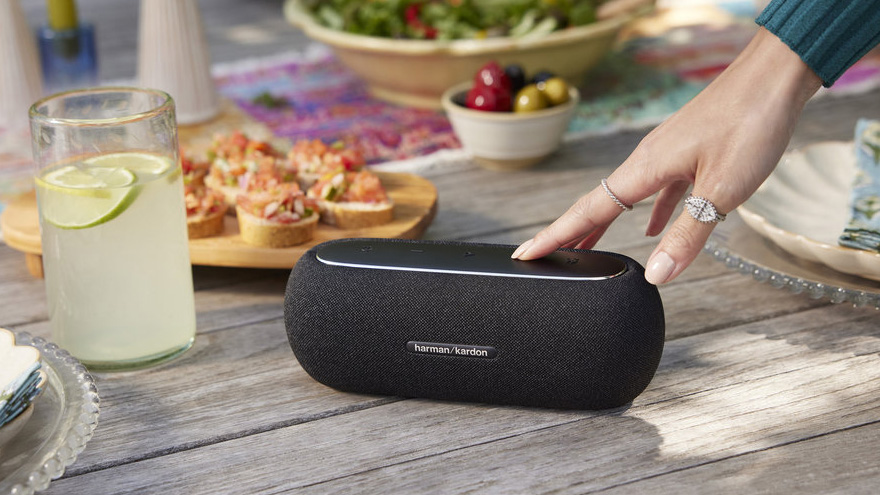Harman Kardon's new Bluetooth speakers bring back a Jony Ive design icon, with a twist
Three new speakers for different sizes – and one is real funky

It’s been 70 years since Dr Sidney Harman and Bernard Kardon established their hi-fi company in Westbury, New York. The company has been responsible for some game-changing products over the past seven decades, and the company has announced three new products to celebrate.
The most striking of these, at least in terms of design, is the Aura Studio 4 Bluetooth speaker. Harman Kardon is far from the first company to revisit past glories when developing a product to celebrate a big birthday, and given that Harman's Jonny Ive-designed SoundSticks speakers now form part of the permanent collection in New York’s Museum of Modern Art, the company has been more than justified in taking some inspiration from what is unarguably an iconic product.
The Aura Studio range particularly evokes the subwoofer of the famous glass SoundSticks design, and is both a striking piece of industrial design and a thoroughly specified speaker – and as a bonus, the Auro Studio 4 represents Harman Kardon’s first use of recycled materials in its range.

A downward-firing 132mm bass driver works in conjunction with a six-driver array in an effort to create a spacious, precise sound. The transparent cabinet affords a view of 324 individual crystals at its base – these illuminate in different colors to put on a fun light show to match the music, which is a new addition for this fourth version.
The Aura Studio is expected to launch at €329 (approx. $360 / £280 / AU$540), putting it in the mid-range of the best wireless speakers – it's competing with the likes of the Sonos Era 100 and Apple HomePod 2 there.
Elsewhere, the latest version of the Go+Play is a Bluetooth speaker of slightly more standard design, given that it’s an evolution of Harman Kardon’s very successful range of portable speakers with an almost semi-circular silhouette.
The Go+Play 3 features three-way stereo drivers including an exposed, down-firing bass driver, and will play for up to eight hours before its battery requires recharging, which is a bit disappointing – the Tribit Stormbox Blast is rated for 30 hours of playback. But no matter where you use it, its ability to automatically calibrate itself to its surroundings means it should always sound its best. It’s constructed from a combination of aluminium and textile, and has touch-controls as part of its tempered glass top panel. Two Go+Play 3 speakers can form a stereo pair if you’re after the biggest sound possible.
Sign up for breaking news, reviews, opinion, top tech deals, and more.
The Go+Play 3 is expected to cost €349 (approx. $380 / £275 / AU$670), putting it in line with something like the UE Hyperboom – portable, but large and serious.

The new Harman Luna portable Bluetooth speaker is the most compact of the three products, and more like the most popular entries in our best Bluetooth speakers guide.
You've got 12 hours of battery life, an IP67 rating against water and dust, a two-way driver set-up and the opportunity to pair a couple together for true stereo sound are among the specification highlights, while the fabric-and-aluminium construction (available in grey or black) means it should really be as tactile as it is portable.
At €179 (approx. $195 / £150 / AU$295), the Luna looks right it line with the Sonos Roam, which also features a two-way speaker design with waterproofing.
All three of these Bluetooth speakers are on sale from September 15, 2023.


Simon Lucas is a senior editorial professional with deep experience of print/digital publishing and the consumer electronics landscape. Based in Brighton, Simon worked at TechRadar's sister site What HiFi? for a number of years, as both a features editor and a digital editor, before embarking on a career in freelance consultancy, content creation, and journalism for some of the biggest brands and publications in the world.
With enormous expertise in all things home entertainment, Simon reviews everything from turntables to soundbars for TechRadar, and also likes to dip his toes into longform features and buying guides. His bylines include GQ, The Guardian, Hi-Fi+, Metro, The Observer, Pocket Lint, Shortlist, Stuff T3, Tom's Guide, Trusted Reviews, and more.
- Matt BoltonManaging Editor, Entertainment